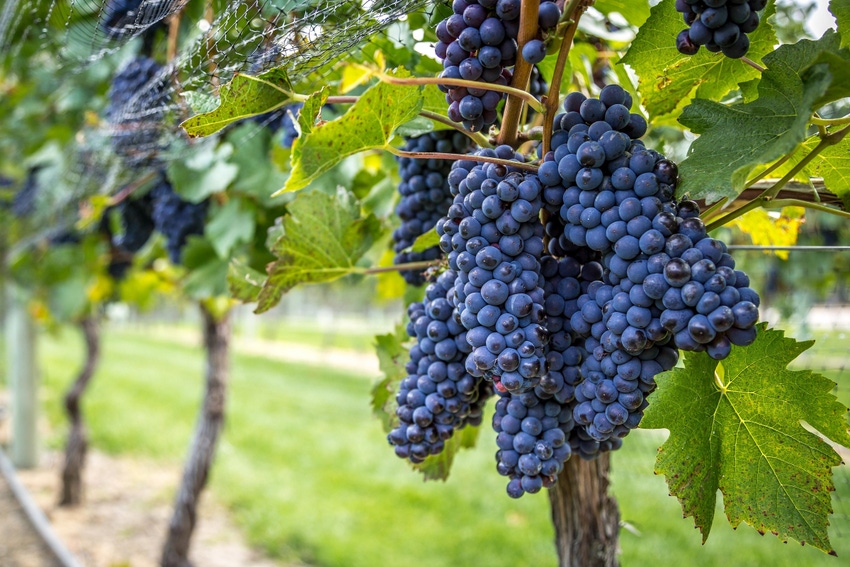
Blueberries foot the bill for starting Santa Barbara County vineyard
Today, Sandy Newman and her five full-time employees at Forbidden Fruit Orchards, near Lompoc, Calif., grow a cornucopia of other fruits, ranging from apples and avocados to hardy kiwis and black tea plants, along with 2.5 acres of Chardonnay and 5 acres of Pinot Noir grapes.

Armed with a master’s degree in plant science; a mortgage on a newly-purchased 100-acre parcel of sandy soils and some apple trees; a passion for growing and picking fruit; and the desire to take on a challenge, Sandy Newman set out in 2002 to grow wine grapes in North Santa Barbara County.
But first, she needed the cash to carry her through the nine or 10 years she estimated it would take before sales of the grapes would begin to cover the cost of producing them.
So, following the advice of her county University of California Cooperative Extension small farm advisor, Newman decided to try her hand first at a more lucrative use of her resources –growing organic blueberries – not just any blueberries, but those that would produce a crop at her site in the off-season, when limited supplies tend to push prices upward. This would avoid competing with the large crops that hit the market during the regular season and, typically, put downward pressure on prices.
“But, how do I know if my location will produce an off-season crop?” Newman asked the advisor.
“Plant an acre or two and see what happens,” he replied.
So she did – putting her vineyard plans on hold and expanding her blueberry plantings to a total of 8.5 acres. She harvests two crops a year – one in the spring, from March into June; the other from late August through November. She sells the fruit to upscale grocers from Los Angeles to San Francisco and at various farmers markets.
Today, she and her five full-time employees at Forbidden Fruit Orchards, near Lompoc, Calif., also grow a cornucopia of other fruits, ranging from apples and avocados to hardy kiwis and black tea plants, along with 2.5 acres of Chardonnay and 5 acres of Pinot Noir grapes.
She planted the first of her grape vines in 2007and hired a viticultural consultant to look over her shoulder, checking her progress every few weeks for the first two years. “Even though I was a horticulturist, I had no experience growing grapes,” she says.
Newman produced her first wines in 2011. Bottled under her Cebada Vineyards label, the wines account for about two-thirds of her crop. She sells the remaining grapes to other boutique wineries.
Located on a southern slope about 12 miles east of the Pacific Ocean in the Santa Ynez Valley AVA, the site of her vineyard is ideal for her grapes, Newman notes.
“The east-west mountain range funnels cool, temperate weather inland making for great Pinot Noir and Chardonnay vineyards,” she says. “This allows us to let the fruit hang and ripen slowly, adding wonderful flavors but maintaining its crispness.”
Winter rainfall in each of the previous five or six year has totaled about 8 to 10 inches. Since last October, her vineyards have received four times that amount. “I’ve never had any frost on the farm, which sits at an elevation of 550 feet,” she says. “However, neighbors closer to sea level often get frost.”
During the summer, daily temperatures range from lows in the lower 60s to highs in the upper 80s, occasionally creeping into the lower 90s. Morning fog frequently hides the sun until about 9 a.m. or 10 a.m.
“The south-facing vineyard is right in the sweet spot,” Newman says. “So, the fruit ripens nicely. The coastal weather here preserves the natural acids without accumulating high sugar levels.”
In fact, to prevent loss of those acids as temperatures typically rise to the high 90s and low 100s in late August, Newman is one of the first growers in her area to begin picking grapes. Usually, she starts harvesting her crop in late July, picking the grapes in the range of 18 to 22 ºBrix.
“Because I make Burgundy-style wines, I don’t want to let the grapes hang a long time,” she notes. “My wines are very low in alcohol, in the 12 percent range, and balanced in the French style.”
Over time, Newman has been reducing yields in her vineyard to achieve the high quality she desires in the grapes. She thins the crop to 12 shoots per plant.
Supported by good groundwater levels, Newman drip-irrigates her vines and other crops.
One of the primary disease threats to her vineyard is Pierce’s disease. The bacterial disease, which attacks the vines, is spread by several insects, including the glassy-winged sharpshooter and the blue-green sharpshooter. Although too early to tell for sure, her efforts to control the disease using insecticides appear to be paying off, Newman says.
Meanwhile, timely preventive treatment of vines with fungicide sprays help minimize her two other main disease risks – powdery mildew and botrytis.
To limit bird damage on her farm, Newman covers her vines and all her other fruit crops with netting.
Her emphasis on growing quality grapes and other fruit comes at a price, says Newman, who offers private tours of her vineyard, including wine tasting
“For example, unlike large growers who hedge their blueberry bushes, here at our farm we hand prune each bush to rejuvenate growth and keep them productive, “ she says. “This results in better fruit but it also costs more than using a machine. The public needs to learn that.”
About the Author(s)
You May Also Like



